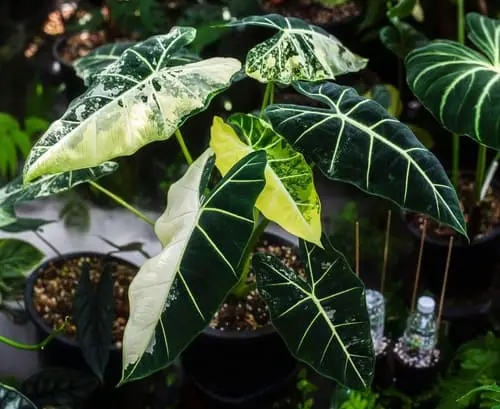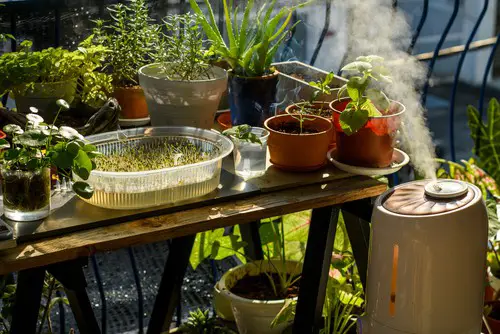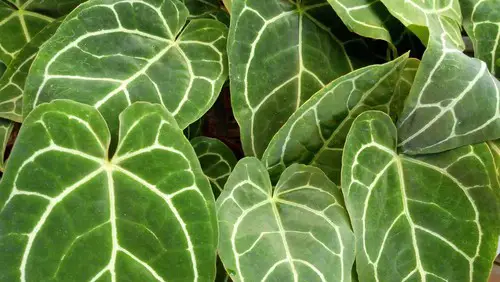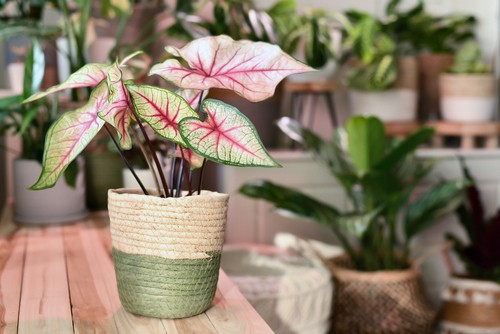The elephant ear plant is a tropical houseplant known for its large, drooping leaves that resemble the ears of an elephant. While this plant can thrive indoors, it is not uncommon for its leaves to droop, which can be a cause for concern for many plant owners.
Understanding the causes of drooping elephant ear leaves and how to address them is crucial for maintaining the health and beauty of this stunning plant.
To ensure the ideal conditions for growth, elephant ear plants require bright, indirect light, high humidity, and well-draining soil. However, even with proper care and maintenance, the leaves of the plant may still droop due to a variety of reasons.
These can include over or under-watering, lack of nutrition, temperature stress, and pest infestations. Identifying the cause of drooping is essential for addressing the issue and preventing further damage to the plant.
Key Takeaways on Elephant Ear Plant Indoor Drooping
- Elephant ear plants are tropical houseplants known for their large, drooping leaves.
- Proper care and maintenance, including ideal growing conditions, can prevent drooping, but various factors can cause it, such as over or under-watering, lack of nutrition, temperature stress, and pest infestations.
- Identifying the cause of drooping is crucial for addressing the issue and maintaining the health of the plant.
Check out these other similar posts:
Understanding Elephant Ear Plants

Origin and Species
Elephant ear plants, also known as elephant ears, belong to the Araceae family and are native to Asia. The genus includes three main species: Colocasia, Alocasia, and Xanthosoma. Colocasia is the most common and widely grown species, while Alocasia and Xanthosoma are less common.
Physical Characteristics
Elephant ear plants are known for their large, green leaves that resemble the ears of an elephant. The leaves can grow up to three feet in length and two feet in width, making them a popular choice for indoor and outdoor gardens.
The leaves are typically heart-shaped and have a glossy texture. The stems are thick and sturdy, providing support for the large leaves.
There are several different varieties of elephant ear plants, each with its own unique physical characteristics. Caladium, for example, has variegated leaves with splashes of white or pink. Some varieties of Alocasia have leaves with striking patterns and colors, such as the Alocasia ‘Polly’ with its dark green leaves and white veins.
In addition to their striking appearance, elephant ear plants are also known for their air-purifying properties. They can remove harmful toxins from the air, making them a popular choice for indoor gardens.
Ideal Conditions for Growth
When it comes to growing an elephant ear plant indoors, providing ideal growing conditions is essential for the plant’s health and to prevent drooping leaves. In this section, we will discuss the light requirements, temperature and humidity, soil, and drainage needs of the elephant ear plant.
1. Light Requirements
Elephant ear plants require bright, indirect light to thrive. Direct sunlight can scorch the leaves, while too little light can cause the leaves to droop. Place the plant near a window that receives bright, indirect light for most of the day. If the plant is not receiving enough light, consider using a grow light to supplement natural light.
2. Temperature and Humidity

Elephant ear plants prefer warm temperatures between 65-80°F (18-27°C) and high humidity levels. Keep the plant away from drafty areas and air conditioning vents, which can cause temperature stress.
To increase humidity levels, place a tray of water near the plant or use a humidifier. Misting the plant’s leaves can also help increase humidity levels.
3. Soil and Drainage
Elephant ear plants require well-draining soil that is kept consistently moist. Use a potting mix that contains peat moss, perlite, and vermiculite to ensure good drainage. Avoid using heavy soils that can cause water to accumulate around the roots, leading to root rot. Ensure that the pot has drainage holes to allow excess water to escape.
Plant Care and Maintenance
Taking care of your indoor elephant ear plant is essential to ensure it stays healthy and vibrant. Proper plant care involves a few key factors, including watering needs, fertilizer use, pruning, and repotting.
1. Watering Needs
Elephant ear plants require consistent and appropriate watering to thrive. Overwatering can lead to root rot and other problems, while underwatering can cause the leaves to wilt and droop.
It is recommended to water the plant when the top inch of soil feels dry to the touch. Be sure to use well-draining soil and avoid letting the plant sit in standing water.
2. Fertilizer Use
Elephant ear plants are heavy feeders and require regular fertilization to maintain their growth and health. A balanced fertilizer with higher nitrogen content is recommended for optimal growth. Be sure to follow the instructions on the fertilizer package and avoid over-fertilizing, as this can lead to burning of the leaves.
3. Pruning and Repotting
Pruning and repotting are essential parts of elephant ear plant care. Prune any yellow or damaged leaves to encourage new growth and maintain the plant’s health. Repot the plant every 1-2 years or when it outgrows its current container. Use fresh soil and a pot that is one size larger than the current one.
Identifying and Addressing Drooping

Elephant ear plants are a popular indoor plant due to their large, heart-shaped leaves that can grow up to three feet long and two feet wide. However, one common issue with these plants is drooping leaves. In this section, we will explore the causes of drooping and provide solutions and prevention methods.
Elephant Ear Plant Indoor Drooping – 5 Common Problems
There are several reasons why elephant ear plants may experience drooping leaves. Some of the most common causes include:
- Underwatering: When elephant ear plants do not receive enough water, their leaves may turn yellow or droop. This is because the plant is trying to conserve water already present in the leaves. To fix this issue, ensure that the plant is watered regularly and that the soil is moist but not waterlogged.
- Overwatering: Overwatering can also cause drooping leaves, as it can lead to root rot and other issues. It is important to allow the soil to dry out slightly between waterings and to ensure that the plant is not sitting in standing water.
- Fertilizer Application Errors: Applying too much or too little fertilizer can cause issues with elephant ear plants, including drooping leaves. Be sure to follow the recommended guidelines for fertilizer application.
- Temperature Stress and Drafts: Elephant ear plants prefer warm temperatures and do not do well in cold drafts. Ensure that the plant is kept in a warm, stable environment.
- Low Humidity: Elephant ear plants thrive in humid environments, and low humidity can cause their leaves to droop. Consider using a humidifier or placing a tray of water near the plant to increase humidity levels.
Solutions and Prevention
To address drooping leaves in elephant ear plants, it is important to identify and address the underlying cause. Here are some solutions and prevention methods:
- Watering: Ensure that the plant is watered regularly and that the soil is moist but not waterlogged. Use well-draining soil and avoid overwatering.
- Fertilizer Application: Follow recommended guidelines for fertilizer application and avoid over-fertilizing.
- Temperature Control: Keep the plant in a warm, stable environment and avoid exposing it to cold drafts.
- Humidity Control: Increase humidity levels by using a humidifier or placing a tray of water near the plant. Consider grouping plants together to create a more humid environment.
- Repotting: If the plant is root-bound, it may need to be repotted in fresh soil. Be sure to choose a pot that is slightly larger than the current one.
- Pruning: Prune any damaged or yellowing leaves to encourage new growth and prevent further damage.
Common Pests and Diseases

Recognizing Pest Infestation
The elephant ear plant is susceptible to a variety of pests such as spider mites, aphids, and mealybugs. These pests can cause the leaves to droop and curl, and may even lead to stunted growth. To identify a pest infestation, look for signs such as webbing, white cotton-like substance on the leaves, and small insects on the plant.
Spider mites are tiny pests that can be difficult to spot with the naked eye. They are usually found on the underside of leaves and can cause yellowing and browning of the leaves. Aphids, on the other hand, are small, soft-bodied insects that can be found on the stems and leaves of the plant.
They can cause stunted growth and the leaves may curl or become distorted. Mealybugs are white, cotton-like pests that can be found on the stems and leaves of the plant. They can cause yellowing and wilting of the leaves.
Disease Identification and Treatment
In addition to pests, the elephant ear plant is also susceptible to diseases such as root rot. Root rot is caused by overwatering and can lead to the plant becoming weak and drooping. To identify root rot, look for signs such as yellowing leaves, wilting, and a foul odor coming from the soil.
To treat pest infestations, use a mild insecticide or a solution of water and dish soap. For mealybugs, use a cotton swab dipped in rubbing alcohol to remove them from the plant. To prevent future infestations, keep the plant clean and remove any dead leaves or debris.
To treat root rot, remove the plant from the soil and inspect the roots. If they are brown and mushy, trim them back to healthy tissue and repot the plant in fresh soil. Water the plant sparingly until it shows signs of new growth.
Special Considerations for Indoor Elephant Ear Plants
1. Winter Care
During the winter months, indoor plants require special care to survive. Elephant ear plants are no exception. These plants thrive in warm, humid environments, so it’s important to keep them in a room with a temperature of at least 60°F. If the room temperature drops below this, the plant may begin to droop and suffer.
If you live in an area with cold winters, you may need to move your indoor elephant ear plant to a warmer location. A basement or garage may be too cold, so consider moving the plant to a room with a space heater or a warm, sunny window. Be sure to keep the plant away from cold drafts, as this can also cause drooping.
2. Toxicity Considerations
Elephant ear plants are toxic to both humans and pets. The plant contains calcium oxalate crystals, which can cause irritation and swelling of the mouth and throat if ingested. In severe cases, this can lead to difficulty breathing.
If you have small children or pets in your home, it’s important to keep your elephant ear plant out of reach. Consider placing the plant on a high shelf or in a room where children and pets are not allowed. If you do come into contact with the plant, be sure to wash your hands thoroughly to avoid any irritation.
Conclusion

Elephant Ear plant is a beautiful and popular indoor plant that can add a tropical feel to any room. However, drooping leaves can be a common problem for this plant. It is important to ensure that the plant is healthy and well-cared for to prevent drooping.
A horticulturist can provide valuable advice on how to care for the Elephant Ear plant. It is important to ensure that the plant is in a well-draining pot and the soil is not too wet or too dry. Overwatering and underwatering can both cause the leaves to droop.
Regular fertilization and proper nutrition can also help prevent drooping leaves. Elephant Ear plants require a lot of nutrients to grow healthy leaves. Temperature stress and drafts can also cause drooping leaves, so it is important to keep the plant in a stable environment.
If the Elephant Ear plant is drooping after repotting, it may need time to rest and recover. It is important to give the plant time to adjust to its new environment and avoid overwatering during this time.
Frequently Asked Questions
What to do if your elephant ear plant is drooping?
If your elephant ear plant is drooping, the first thing to do is to check the soil moisture. Overwatering or underwatering can cause elephant ear leaves to droop.
If the soil is too dry, water the plant thoroughly and ensure that the soil is moist but not waterlogged. If the soil is too wet, allow it to dry out before watering again.
What do overwatered elephant ears look like?
Overwatered elephant ears may have yellowing leaves, a mushy stem, or a sour smell coming from the soil. The leaves may also appear wilted or droopy. If you suspect that your elephant ear plant is overwatered, reduce watering frequency and allow the soil to dry out before watering again.
Should you stake elephant ears?
Staking elephant ears is recommended if the plant becomes too tall or top-heavy. Use a bamboo stake or a trellis to support the stem and leaves. Be sure to tie the plant to the stake loosely to avoid damaging the stem.
How do you revive a dying elephant ear?
To revive a dying elephant ear, first identify the cause of the problem. Check the soil moisture, lighting, and temperature conditions. Adjust these factors as needed. If the plant is severely wilted, prune back any dead or damaged foliage and repot the plant in fresh, well-draining soil.
Why Are My Elephant Ear Leaves Drooping?
Elephant ear leaves may droop due to several reasons such as underwatering, overwatering, lack of nutrition, temperature stress, low humidity, insufficient light, or water quality issues. Check the plant’s environment and adjust as necessary to address the issue.
Should I Cut Off Drooping Elephant Ears?
If the drooping leaves are due to overwatering or underwatering, it is best to remove them to prevent further damage to the plant. If the leaves are wilted due to environmental factors, it may be possible to revive them by adjusting the plant’s conditions. In general, it is best to prune away any dead or damaged foliage to promote healthy growth.

Hey, I’m Lisa and I’ve been an avid gardener for over 30 years. I love writing, talking and living in the garden! Feel free to connect with me on my socials below

